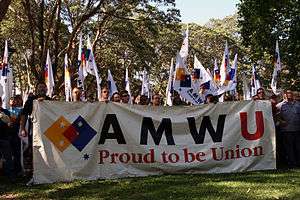Australian Manufacturing Workers Union
.png) | |
| Full name | Automotive, Food, Metals, Engineering, Printing and Kindred Industries Union |
|---|---|
| Founded | 1995 |
| Members | 93,805 (2013) [1] |
| Affiliation | ACTU, IndustriALL, ALP |
| Key people | Paul Bastian, National Secretary |
| Office location | 133 Parramatta Rd, Granville, New South Wales |
| Country | Australia |
| Website | www.amwu.asn.au |
The Australian Manufacturing Workers Union, or more fully, the Automotive, Food, Metals, Engineering, Printing and Kindred Industries Union (AMWU) is an Australian trade union. The AMWU represents a broad range of workers in the manufacturing sector, as well as associated industries, and is affiliated to the Australian Council of Trade Unions.
The union is organised into six state branches, as well as four divisions, representing different industries or occupational groups: the Manufacturing Division, the Food and Confectionery Division, the Vehicle Division and the Printing Division.
History
The AMWU has its origins in the amalgamation of three metal trade unions - the Boilermakers and Blacksmiths Society of Australia (BBS), the Sheet Metal Working Industrial Union of Australia (SMWU) and the Amalgamated Engineering Union (AEU) - to form the Amalgamated Metal Workers Union (AMWU) in 1972. At its formation the AMWU had a membership of 171,000, making it the largest organisation in Australia by membership.[2]

Seven years later, after amalgamation with the Federated Shipwrights and Ship Constructors Union of Australia, the AMWU changed its name to the Amalgamated Metal Workers and Shipwrights Union (AMWSU). When the Federated Moulders’ (Metals) Union amalgamated in 1983, the union's name changed slightly to the Amalgamated Metals Foundry & Shipwrights’ Union, but in 1985 reverted to the Amalgamated Metal Workers’ Union. By 1987 the union's membership had declined slightly to 163,400.[3]
During the 1980s the AMWU played a pivotal role in securing the support of the left wing of the Australian union movement for the Prices and Incomes Accord, which involved unions agreeing to restrict their demands for wage increases in exchange for the federal government implementing policies to advance the 'social wage', including universal health insurance, investment in education and social welfare.[4]
In 1991 the AMWU amalgamated with the Association of Draughting Supervisory & Technical Employees (ADSTE) created the Metals and Engineering Workers’ Union. Two years later a further amalgamation with the Vehicle Builders Employees’ Federation of Australia resulted in the Automotive Metals & Engineering Union. In 1994 the union merged with the Confectionery Workers' and Food Preservers’ Union, itself a recent amalgamation of the Food Preservers' Union of Australia and the Confectionery Workers' Union of Australia, to form the Automotive Food Metals and Engineering Union. Finally, the Printing and Kindred Industries Union amalgamated to form the printing division of the Automotive, Food, Metals, Engineering, Printing and Kindred Industries Union.
During the 1990s and 2000s membership of the AMWU declined dramatically, (reflecting the general decline of trade unionism in Australia as well as contraction of the manufacturing sector in Australia) falling from 200,000 in 1995 to 157,000 in 2005.[3]
National Secretaries
- 1973: Jack Garland
- 1981: Jack Kidd
- 1988: George Campbell
- 1996: Doug Cameron
- 2008: Dave Oliver
- 2012: Paul Bastian
Political Activity
During the 2010 Federal election the CFMEU and AMWU donated a total of $60,000 to the Greens.[5]
Further reading
- Reeves, Andrew and Andrew Dettmer (eds.) Organise, educate, control: the AMWU in Australia, 1852-2012. Clayton, Victoria: Monash University Publishing, 2013. ISBN 9781922235008.
External links
References
- ↑ Australian Manufacturing Workers Union (21 March 2014). "2014 Annual Returns" (PDF). List of registered organisations. Fair Work Commission. Retrieved 29 March 2015.
- ↑ Huntley, Pat (1980). Inside Australia's Top 100 Unions. Middle Cove, NSW: Ian Huntley (Aust.). pp. 141–145. ISBN 0-9598507-4-0.
- 1 2 Docherty, James C. (2010). The A to Z of Australia. Maryland: The Scarecrow Press. p. 13. ISBN 978 0 8108 7634 7.
- ↑ Briggs, Chris (2004). "The End of a Cycle? The Australian Council of Trade Unions in Historical Perspective". In Ellem, Bradon; Markey, Raymond; Shields, John. Peak Unions in Australia: Origins, Purpose, Power, Agency. Leichhardt: The Federation Press. p. 247. ISBN 1 86287 530 8. Retrieved 5 October 2018.
- ↑ Keane, Bernard (1 February 2012). "Electoral funding figures show Labor's donations collapse". Crikey. Retrieved 29 April 2014.